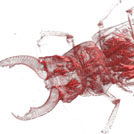
Project in visualization: hands-on experience by implementing a visualization assignment.
Project in Visualization
This course (INF219/INF319, project in visualization) is about realizing a programming project in visualization. INF319 is an important course in the UiB Master study programme in informatics with focus on visualization (MAMN-INFVI). INF319 is a course that can also be taken as part of the PhD study programme.
Prerequisites
Two years of programming experience are required. Many of the INF219/INF319 projects on visualization will be programmed in C/C++ or Java and OpenGl.
Learning Outcomes
On completion of the course the student should have the following learning outcomes defined in terms of knowledge and skills:
Knowledge:
The student can
- participate in project work in informatics, e.g. a programming project.
- contribute to the written documentation of a project work in the form of a technical report.
- give an oral presentation of a project work in which the student has participated.
Skills
The acquired skills will depend on the project that the student has participated in.
Course Access
Access to the course requires admission to a programme of study at The Faculty of Mathematics and Natural Sciences.
Course Structure
A project will be specified and should be implemented under the guidance of an advisor from the department. Typically this is a programming project, but projects can also cover subjects like literature studies and modeling. Note that there is a limited number of projects. Available projects will be announced at Mitt UiB, and at our website. Questions about available projects can be sent to the study advisor at the Department of Informatics (studieveileder@ii.uib.no).
Compulsory Assignments and Attendance
Written report and oral presentation of the work.
Forms of Assessment
Semester project, passed/failed.
Grading Scale
Pass/fail
Subject Overlap
No overlap
Available Projects
Comparative Visualization of Protein Secondary StructuresProtein Tunnel Reprojection for Physico-Chemical Property Analysis
Tree Diagram Representation of Unfolded Protein Tunnels
View of Multiple Unfolded Protein Tunnels by Aggregation
Visual Exploration of Road Traffic for Sensor Data Fusion
